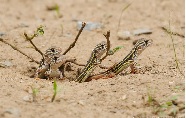 |
Butterfly Lizard Range Map
|
|
|
 |
 |
 |
 |
 |
 |
 |
Butterfly Lizard Juvenile

|
|
|
 |
 |
 |
 |
 |
 |
|
Butterfly Lizard (Leiolepis belliana)
Description: L. belliana is known for the beautiful patterns on its back and sides. It has yellow spots on its back, and small orange and black lines on its sides.
Habitat: Colonies of this species are most often found in low lying, open, flat, sandy areas among patches of grass, coconut palms, and beach vegetation, often in coastal areas. The loose soils in these areas are favorable for the construction of their burrow systems, which can be as deep as 0.75 m with various dead-end tunnels and escape exits that some lizards plug with dirt. Animals are common along riverbanks, especially where deltaic sediments have accumulated along the coast. If the habitat is suitable, lizards will follow the riverbanks inland for considerable distances. During the hottest hours of the day, they are commonly seen basking on piles of dirt, driftwood, stumps, or on the ground. Specimens have been observed are grassy areas along the edge of roadsides and golf courses. They are wary, have a relatively long light distance, and will escape into their burrows at the slightest provocation. It is common to find male-female pairs sharing a burrow, and gravid females have been observed with eight eggs. The breeding season extends throughout the summer months, and males engage in combat by circling one another while extending their bright orange and black barred flanks.. It is found along roadsides and penetrates into disturbed areas. Animals are active seasonally, and retreat into their burrows in the dry season.
Range: L. belliana digs and lives in a burrow about 12 inches deep and 28 inches long, to which it returns before dark, and uses its flattened body to seal the entrance to protect it from nocturnal predators. These burrows are also used during reproduction and as refuge from weather and fires.
Invasive species in Florida. The Miami population of L. belliana originated from a tropical fish dealer, and the population was already well established in 1992. L. belliana is readily available in the pet trade, and reptile collectors are probably not exploiting the Miami population because this species is located on private properties in a residential area, difficult to catch, and not worth much as individuals typically wholesale for $3.50–5.50 each. The ecological impacts of L. belliana on native species in Florida are unknown.
Found in these States:
FL
Diet: The butterfly lizard feeds on vegetation, crabs, grasshoppers, beetle larvae, butterflies, and other insects.
Reproduction: L. belliana is monogamous, with a single adult pair inhabiting the same burrow, where 3-8 eggs are laid during hot, dry weather. This species also exhibits parental care of neonates, with neonates sharing their parents' burrow for a few months before digging their own burrow nearby.
Status: It is considered locally common. It is common in protected areas in Thailand and in some protected areas in Cambodia, but is rare elsewhere due to harvesting. The species is likely to have declined historically in areas where it is heavily harvested, but the population is probably stable across its range as a whole.
»» Kingdom: Animalia - Animals
»» Phylum: Chordata - Chordates
»» Subphylum: Vertebrata - Vertebrates
»» Class: Reptilia - Reptiles
»» Order: Squamata - Lizards
»» Family: Agamidae - Dragon Lizards
»» Genus: Leiolepis
»» Species: Leiolepis belliana - Butterfly Lizard
»» Subspecies: None
This article uses material from the Wikipedia article "Butterfly Lizard", which is released under the Creative Commons Attribution-Share-Alike License 3.0. Content may have been omitted from the original, but no content has been changed or extended.
|
|







